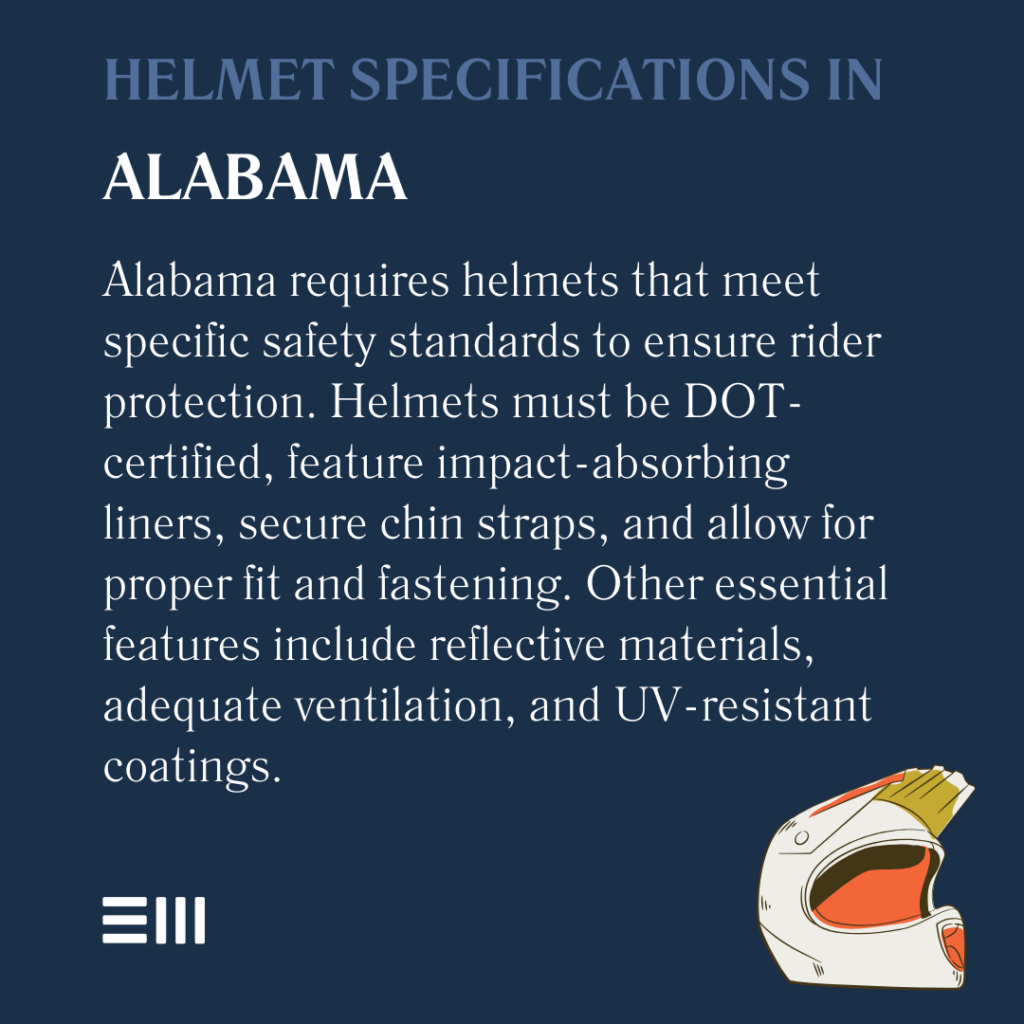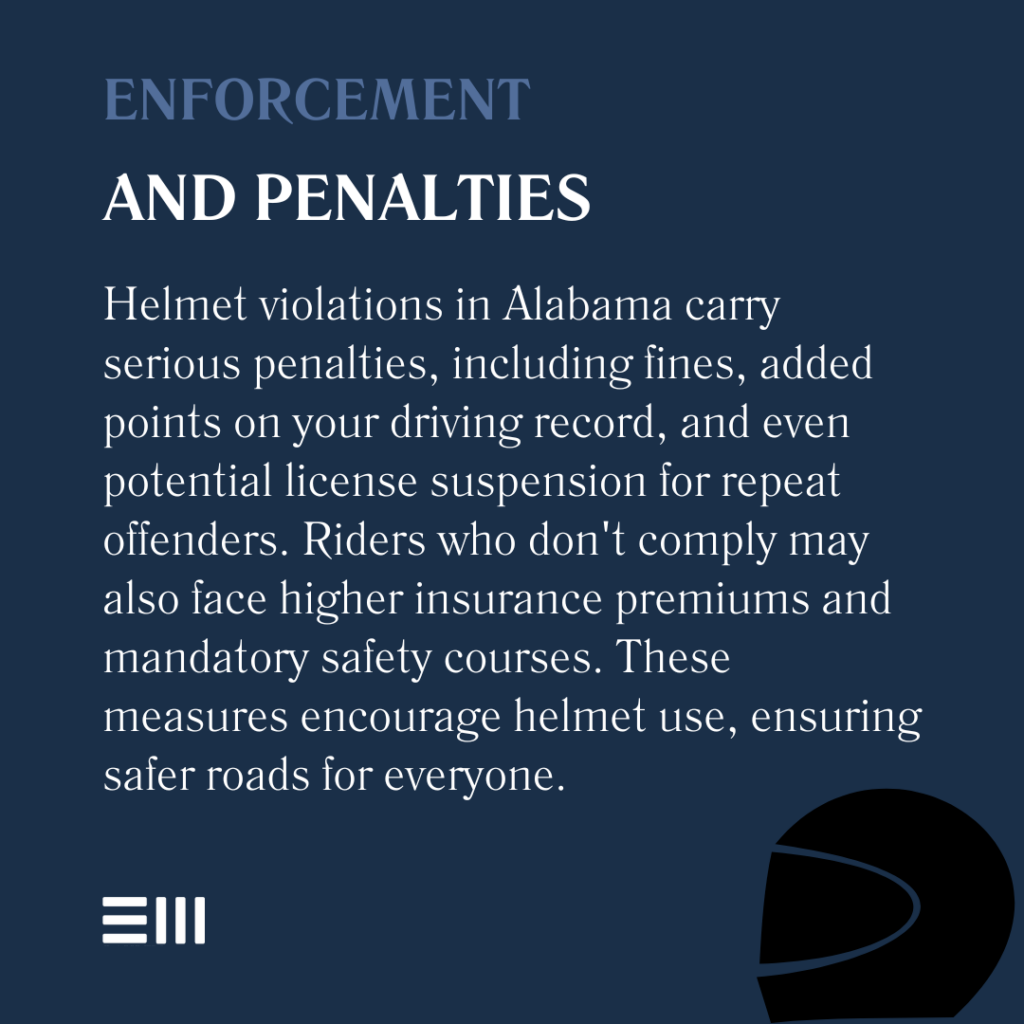
Every morning across Alabama, motorcyclists swing their legs over their bikes and hit the open road. For some, the helmet they strap on represents an unwanted restriction on personal freedom.
For others, it’s a lifesaving shield they wouldn’t ride without.
Beyond personal choice lies Alabama’s clear stance on motorcycle safety, backed by laws that affect every rider who crosses state lines.
The debate between freedom and safety continues to shape discussions about helmet requirements, even as research consistently demonstrates their life-saving potential.
Understanding Alabama’s Helmet Requirements
Alabama maintains some of the strictest helmet laws in the southeastern United States. These requirements affect not only motorcyclists but also operators of other motorized vehicles, creating a comprehensive approach to head protection on Alabama roads.
The state’s commitment to universal helmet laws reflects decades of research and experience in traffic safety. Understanding these requirements helps riders stay compliant while protecting themselves on Alabama highways.
The evolution of these laws demonstrates Alabama’s ongoing commitment to balancing rider safety with practical implementation.
Motorcycle Helmet Specifications
Not all helmets meet Alabama’s legal requirements. The state sets specific standards for protective headgear to ensure maximum safety for riders and passengers.
Required helmet features in Alabama include:
- DOT (Department of Transportation) certification;
- Impact-absorbing liner;
- Sturdy chin strap with solid rivets;
- Proper fit and secure fastening;
- Visibility-enhancing reflective materials;
- Adequate peripheral vision allowance;
- Interior padding requirements;
- Exterior impact resistance;
- Ventilation systems;
- Weather protection features;
- Proper weight distribution;
- Sound attenuation properties;
- UV-resistant coating;
- Moisture-wicking interior; and
- Anti-fog treatment options.
Each of these specifications plays a vital role in protecting riders during accidents and must be maintained for legal compliance.
Regular inspection and maintenance of these features ensure continued protection and legal operation.

Legal Requirements for Different Vehicles
Alabama’s helmet laws extend beyond traditional motorcycles to cover various motorized vehicles. Understanding which vehicles require helmets helps operators stay compliant and safe.
Vehicles affected by helmet laws include:
- Standard motorcycles;
- Motor-driven cycles;
- Motor scooters;
- Mopeds;
- Three-wheeled vehicles;
- Electric bicycles above certain speeds;
- All-terrain vehicles on public roads;
- Autocycles without enclosed cabs;
- Modified recreational vehicles;
- Racing vehicles on public roads;
- Mini-bikes and pocket bikes;
- Custom-built motorcycles;
- Converted bicycles with motors;
- Agricultural vehicles on highways; and
- Exhibition vehicles during events.
These requirements ensure consistent safety standards across different vehicle types while recognizing their unique characteristics and operational needs.
Enforcement and Penalties
Alabama law enforcement takes helmet violations seriously. Understanding the consequences of non-compliance helps riders make informed decisions about helmet use and maintenance.
Potential penalties include:
- Monetary fines starting at $100;
- Points added to driving record;
- Increased insurance premiums;
- Mandatory safety course attendance;
- Vehicle impoundment possibilities;
- License suspension for repeat offenders;
- Court costs and legal fees;
- Enhanced penalties for accidents;
- Insurance coverage implications;
- Secondary violation considerations;
- Community service requirements;
- Probationary riding periods;
- Mandatory equipment inspections;
- Safety awareness program participation; and
- Required riding skill assessments.
These enforcement measures aim to encourage compliance rather than merely punish violations, promoting safer riding practices across the state.

Medical and Insurance Implications
Helmet use affects more than just legal compliance. Understanding the medical and insurance implications helps riders appreciate the full impact of helmet laws on their personal and financial well-being.
Key considerations include:
- Insurance coverage requirements;
- Medical payment limitations;
- Personal injury protection;
- Long-term disability implications;
- Healthcare cost responsibilities;
- Accident liability considerations;
- Recovery period impacts;
- Treatment option availability;
- Rehabilitation coverage;
- Future insurability concerns;
- Pre-existing condition implications;
- Family medical planning;
- Life insurance considerations;
- Disability insurance requirements; and
- Workers’ compensation impacts.
These factors demonstrate how helmet use influences both immediate and long-term financial security for riders and their families.
Safety Standards and Testing
Understanding how helmets are tested and certified helps riders make informed choices about their protective gear.
Alabama follows federal guidelines for helmet certification while maintaining additional state-specific requirements.
Important testing elements include:
- Impact absorption testing;
- Penetration resistance;
- Retention system strength;
- Field of vision requirements;
- Weight distribution analysis;
- Temperature exposure tests;
- Chemical resistance evaluation;
- Weathering simulations;
- Sound attenuation testing;
- Comfort assessment protocols;
- Ventilation efficiency tests;
- Shell integrity verification;
- Interior padding durability;
- Strap strength measurement; and
- Environmental exposure testing.
These rigorous testing procedures ensure helmets provide reliable protection under various conditions.
Out-of-State Rider Requirements
Visitors to Alabama must understand how local helmet laws affect their rides.
Different states maintain varying requirements, but Alabama’s laws apply to all riders within state boundaries.
Important considerations include:
- Immediate compliance requirements;
- Recognition of other state licenses;
- Tourism impact considerations;
- Interstate travel regulations;
- Temporary resident requirements;
- Military personnel exceptions;
- Student status implications;
- Business travel considerations;
- Event participation rules;
- Cross-border commuting rules;
- International license recognition;
- Special event exceptions;
- Group ride requirements;
- Tour operator responsibilities; and
- Emergency situation protocols.
Understanding these requirements helps visitors avoid legal issues while riding in Alabama.
Maintenance and Replacement Guidelines
Proper helmet maintenance and timely replacement ensure continued protection and legal compliance. Following manufacturer recommendations helps maintain helmet effectiveness.
Essential maintenance practices include:
- Regular inspection schedules;
- Cleaning procedures;
- Storage requirements;
- Impact assessment protocols;
- Wear indicator monitoring;
- Strap maintenance;
- Visor care procedures;
- Ventilation system cleaning;
- Padding replacement schedules;
- Shell inspection guidelines;
- Hardware tightening routines;
- Comfort liner care;
- Weather protection maintenance;
- Documentation requirements; and
- Professional inspection scheduling.
These maintenance procedures help extend helmet life while ensuring continued protection.
Frequently Asked Questions About Helmet Laws in Alabama
Motorcycle enthusiasts often have questions about Alabama’s helmet requirements.
Here are answers to common inquiries about helmet laws and compliance.
Where Can I Find DOT-Approved Helmets?
Licensed motorcycle dealers and approved safety equipment retailers sell compliant helmets throughout Alabama. Look for authorized dealers who provide proper fitting services.
How Often Should I Replace My Helmet?
Manufacturers recommend replacement every 3-5 years or immediately after any impact, regardless of visible damage.
What if My Helmet Gets Damaged?
Replace damaged helmets immediately, as their protective capabilities may be compromised, even if damage appears minor.
Do Passengers Need Helmets?
Yes, all motorcycle passengers must wear DOT-approved helmets regardless of age or experience level.
Can I Use a Bluetooth Device?
Helmet-mounted communication devices are allowed if they don’t compromise the helmet’s integrity or safety features.
How Do I Know if My Helmet Fits Properly?
A properly fitted helmet should be snug but not uncomfortable, with no movement during head rotation or normal riding conditions.
What Documentation Should I Keep?
Keep purchase receipts, manufacturer warranties, and inspection records to demonstrate compliance with state requirements.
Are There Exemptions to the Law?
Alabama maintains very few exemptions to helmet requirements, primarily for specific medical conditions with proper documentation.
Protect Your Rights on the Road
Whether you’ve been involved in a motorcycle accident or need guidance on helmet law compliance, our experienced attorneys understand the complexities of Alabama’s motorcycle laws.
Contact us to discuss your situation and ensure your rights remain protected while riding safely on Alabama roads.
Can't find what you're looking for? Search our site below.










